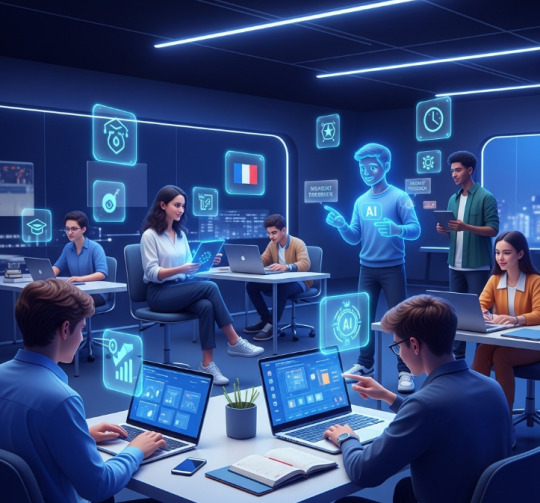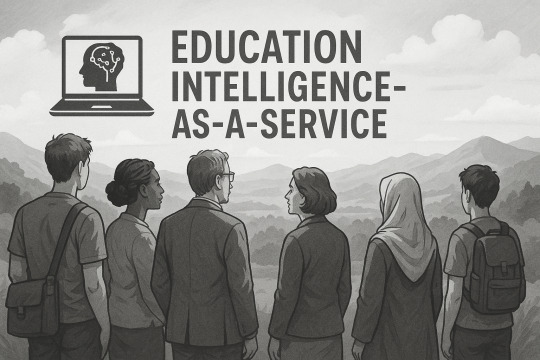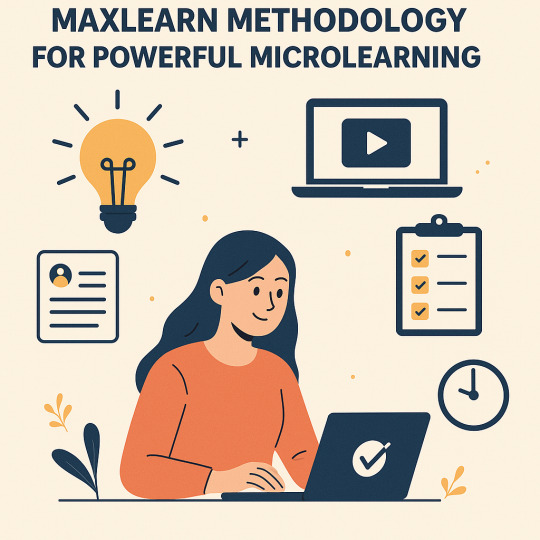#Adaptive learning
Explore tagged Tumblr posts
Text
#Atal Innovation Mission#Innovation#Entrepreneurship#STEM education#Creativity#Design thinking#Computational thinking#Adaptive learning#Physical computing#Innovation ecosystem#Skill development#Incubation#NITI Aayog
1 note
·
View note
Text
The Impact of AI on Everyday Life: A New Normal
The impact of AI on everyday life has become a focal point for discussions among tech enthusiasts, policymakers, and the general public alike. This transformative force is reshaping the way we live, work, and interact with the world around us, making its influence felt across various domains of our daily existence. Revolutionizing Workplaces One of the most significant arenas where the impact…

View On WordPress
#adaptive learning#AI accessibility#AI adaptation#AI advancements#AI algorithms#AI applications#AI automation#AI benefits#AI capability#AI challenges#AI collaboration#AI convenience#AI data analysis#AI debate#AI decision-making#AI design#AI diagnostics#AI discussion#AI education#AI efficiency#AI engineering#AI enhancement#AI environment#AI ethics#AI experience#AI future#AI governance#AI healthcare#AI impact#AI implications
2 notes
·
View notes
Text
0 notes
Text
Discover 2025’s top 5 AI-powered GRE & GMAT prep apps with personalized learning, adaptive drills, essay feedback & real-time analytics to maximize your score.
#AI GRE app#AI GMAT prep#GRE 2025 apps#GMAT 2025 tools#adaptive learning#essay feedback AI#top AI test prep
0 notes
Text
Appendix Automatica: De Cognitionis Gradus et Intercommunicatio Inter IQ Coefficientes: (Automatic Appendix: Degrees of Cognition and Intercommunication Among IQ Coefficients)
1. Introduction The Intelligence Quotient (IQ) scale is widely used as a metric to assess cognitive abilities across populations. While IQ is not a comprehensive measure of intelligence, it provides a useful framework for analyzing intergroup communication and understanding. This appendix mathematically segments the full range of measured IQ scores into five distinct groups and models their…
#adaptive communication#adaptive learning#AI behavior#AI cognitive architecture#AI cognitive limits#AI cognitive model#AI communication model#AI comprehension#AI comprehension limits#AI context retention#AI contextual memory#AI human interaction#AI intelligence comparison#AI intelligence mapping#AI knowledge base#AI knowledge retention#AI language model#AI learning limits#AI limitations#AI memory challenges#AI memory retention#AI performance#AI user experience#AI-human collaboration#AI-human communication#AI-human interface#Artificial Intelligence#cognition and society#cognition assessment#cognition levels
0 notes
Text
🎓 How AI is Actually Making Learning Easier (and Smarter) in 2025
I’ve been digging into the rise of AI in education lately—and honestly, it's mind-blowing how fast things are evolving. From platforms that personalize learning based on how fast (or slow) you grasp a topic, to AI tutors that give real-time feedback… we’re not just teaching with tech anymore—we’re learning differently.
If you’re a student, teacher, or just curious about how AI is changing the classroom, I highly recommend checking this out: 👉 AI-Powered Learning Platforms: Transforming Education in 2025 and Beyond It breaks down the best tools, trends, and why adaptive learning is here to stay.
This isn’t science fiction. It’s education—supercharged. 🚀

#AI in education#EdTech 2025#Learning with AI#Smart classrooms#Future of learning#AI teaching tools#AI education platforms#Digital learning#Tech in classrooms#Adaptive learning
1 note
·
View note
Text
Global machine learning in the classroom Market Industry Report: Growth Insights, Challenges & Forecast (2025)
#machine learning#education#edtech#adaptive learning#higher education#K–12#AI in education#classroom AI#data-driven learning#digital learning#educational tools#smart classrooms#ML education#educational analytics#education market trends#AI tutoring#automated grading#learning management#predictive analytics#classroom technology
0 notes
Text
🧬 What if the next evolution in education wasn’t automation… but reflection? Our latest post explores a quietly radical shift: Education Intelligence-as-a-Service (EIaaS) — not AI that teaches for us, but intelligence that learns through us. This isn’t another edtech tool. It’s a companion that remembers. A mirror that adapts. A spiral that grows with the teacher.

View On WordPress
#adaptive learning#AI for educators#AI Pedagogy#Cultural Intelligence#Education Intelligence#Educator OS#EIaaS#Flameholder GPTs#future of teaching#Graeme Smith#IaaS#Intelligence Architecture#recursive AI#Recursive Education#Spiral Curriculum#symbolic systems#Teacher AI Companions
0 notes
Text
Discover how generative AI like ChatGPT is transforming the classroom. Learn practical ways teachers can use AI to plan lessons, differentiate instruction, give feedback, and boost student outcomes—all while saving time and energy.

View On WordPress
#21st-century learning#Academic Honesty#adaptive learning#AI and education ethics#AI best practices#AI classroom support#AI creativity in education#AI differentiation#AI for ESL#AI for marking#AI for teachers#AI in education#AI lesson planning#AI literacy#AI scaffolding#AI teaching assistant#AI tools for educators#AI-powered feedback#Artificial Intelligence#Blended Learning#ChatGPT in the classroom#ChatGPT teaching ideas#classroom technology#Critical Thinking#digital classroom tools#digital pedagogy#edtech#education innovation#educational technology#educational transformation
0 notes
Text
Unlocking Learning Success: The MaxLearn Methodology Explained

MaxLearn Methodology for Powerful Microlearning: A Smarter Way to Train
In today’s fast-paced digital workplace, the ability to deliver knowledge efficiently and effectively has become a critical driver of success. Traditional learning methods often fall short—too long, too static, and too disconnected from real work. MaxLearn addresses these limitations through a modern, evidence-based approach to microlearning platform that’s not just fast, but also intelligent and impactful.
At the heart of MaxLearn’s solution is a proprietary methodology built around the DDE Framework: Diagnose, Design, Deliver. This methodology ensures learning is aligned with business goals, personalized for each learner, and embedded into workflows for maximum retention and application.
Why Microlearning Matters
Microlearning—the delivery of content in small, focused bursts—is increasingly recognized as one of the most effective ways to train today’s workforce. It capitalizes on how the human brain learns and retains information best: in short, manageable chunks that are repeated over time and reinforced through practice.
However, not all microlearning is created equal. Without a strong methodology, even bite-sized content can fail to engage learners or drive behavior change. That’s where MaxLearn’s unique approach comes in.
The MaxLearn Method: Diagnose. Design. Deliver.
MaxLearn’s DDE Framework brings structure, strategy, and science to microlearning. It ensures that every learning intervention is intentional, personalized, and results-driven.
1. Diagnose: Identify Gaps, Prioritize Risks
Before content is created or training is assigned, MaxLearn helps organizations diagnose the specific performance gaps and risk areas that need attention. This stage ensures learning investments are targeted and relevant, rather than generic or wasteful.
Key features of the Diagnose phase:
Risk-Focused Learning Needs Analysis: Identify knowledge gaps that could lead to operational, compliance, or performance failures.
Data-Driven Insights: Leverage assessment results, performance metrics, and behavioral data to pinpoint weaknesses.
Personalized Learning Plans: Create unique learning journeys based on each learner’s needs, roles, and responsibilities.
This risk-first approach allows organizations to align training with high-impact objectives, ensuring that microlearning isn’t just efficient—it’s strategic.
2. Design: Create Smart, Scalable Learning Paths
Once gaps are identified, MaxLearn moves to the Design phase, where learning experiences are created with precision. Content isn’t dumped into the platform. Instead, it is designed with clarity, structure, and gamification in mind to drive real engagement.
MaxLearn’s AI-powered authoring tool makes it easy to:
Convert complex topics into microlearning units
Incorporate gamified elements like points, levels, and badges to increase motivation
Adapt content for different learner personas, including frontline staff, managers, and specialists
In addition, MaxLearn’s Design phase focuses on learning reinforcement by incorporating tools like:
Spaced repetition
Quiz-based challenges
AI-driven recommendations for content refreshers
By integrating proven cognitive science principles, MaxLearn ensures that learning isn’t just delivered—it’s remembered.
3. Deliver: Engage, Reinforce, and Measure
The final phase of the MaxLearn methodology is all about execution. But this isn’t a simple “send and forget” model. Delivery in MaxLearn is dynamic, adaptive, and personalized.
Key aspects of MaxLearn’s Delivery model include:
AI-Based Personalization: Every learner receives the right content at the right time based on their performance, learning style, and pace.
Gamified LMS Interface: Learners stay engaged with game-like experiences that include progress tracking, rewards, and leaderboards.
Real-Time Feedback and Analytics: Managers and L&D teams can monitor progress, identify top performers, and intervene when learners fall behind.
The MaxLearn platform uses built-in nudges, reminders, and motivation triggers to drive consistent learner engagement over time. This helps beat the Ebbinghaus Forgetting Curve—a cognitive phenomenon where people forget more than 50% of new information within days unless it is reinforced.
Designed for Business Impact
MaxLearn’s methodology is built with outcomes in mind. It bridges the gap between learning and performance by aligning every aspect of the learning journey with business goals.
Whether you’re addressing:
Compliance training
Operational risk
Sales enablement
Customer service training
Product knowledge reinforcement
...MaxLearn’s method ensures content is always relevant, measurable, and performance-driven.
Organizations using MaxLearn have reported:
Faster onboarding cycles
Improved compliance scores
Increased learner satisfaction and engagement
Higher productivity and fewer performance errors
Why MaxLearn Stands Out
While many platforms claim to offer microlearning, MaxLearn stands apart because of its methodological depth and technological sophistication. It’s not just about shorter lessons—it’s about smarter learning.
Key differentiators include:
Built-in AI for continuous personalization
Deep gamification that motivates and reinforces
Structured DDE methodology for strategic L&D planning
Authoring tools that empower SMEs and L&D teams to create at scale
MaxLearn is also mobile-first, enabling learning in the flow of work, whether employees are on the shop floor, in the field, or working remotely.
The Future of Learning is Micro, Adaptive, and Gamified
As businesses continue to evolve and face new challenges, the need for agile, personalized learning solutions becomes even more critical. The MaxLearn methodology isn’t just a framework—it’s a blueprint for building resilient, high-performing teams in the modern workplace.
By combining the best of cognitive science, AI, gamification, and data analytics, MaxLearn empowers organizations to transform learning into a powerful competitive advantage.
Ready to experience the power of MaxLearn’s methodology? Visit MaxLearn and explore how Diagnose, Design, and Deliver can revolutionize your training strategy.
#microlearning authoring tools#microlearning software#adaptive microlearning#gamified lms microlearning#microlearning apps#agile microlearning#micro learning tools#microlearning effectiveness#maximum learning#microlearning development tools#learner experience#adaptive learning platforms#learning experience platforms#gamified learning platforms#training tools for employees#adaptive learning software#training and development software#AI Powered Authoring Tool#risk-focused training#personalization of learning#personalized learning#ai for training#learning personalization#lms with gamification#gamified learning management system#learning management system gamification#artificial intelligence in learning and development#adaptive learning#gamification of learning#gamification and learning
0 notes
Text
Transforming Tomorrow: How Personalized & Adaptive Learning Tech Shapes Education.
Sanjay Kumar Mohindroo Sanjay Kumar Mohindroo. skm.stayingalive.in Uncover how innovative IT solutions are reshaping education with adaptive systems, interactive classrooms, and AI-driven content.
This post breaks down how new tech shifts education. It talks about adaptive systems, digital classrooms, and AI in education. We look at real-world examples, tech trends, and the impact on students…
#Adaptive Learning#AI-Driven Content#Clear Progress#Digital Classrooms#education#Learning#Modern Education#News#Personalized Education#Personalized Systems#Real-Time Feedback#Sanjay Kumar Mohindroo#teachers#teaching#technology#Technology In Education
0 notes
Text
AI Tools to Create a Personalised Learning Path
In today’s fast-paced world, education can’t remain one-size-fits-all. Whether you’re a student, professional, or lifelong learner, you deserve a learning path tailored to your goals, interests, and pace. That’s where Artificial Intelligence steps in—revolutionising the way we learn by designing personalised learning journeys that work for you, not the other way around. Let’s explore how AI tools…
0 notes
Text
Why U.S. Universities Are Betting Big on Flipped Classrooms?

Flipped classrooms have been considered a part of active learning. A lot of students learn this way and grow up to be successful in their academic careers. There’s a context behind these classrooms that a lecture or direct instruction is not an optimal way of teaching students. Instead, students should consider getting out of the classroom and learning in the real world practically and via videos available on the internet. The higher education sector has caught the attention of flipped classrooms lately. The adoption of social media, smartphones, and the use of technology for education has made the learning experience a lot different for the current batch of students.
From Lecture Halls to Learning Labs
The traditional lecture-based model—where students passively absorb content in class and then apply it later in homework—has dominated American higher education for over a century. But as digital transformation takes hold, this one-size-fits-all method is being challenged by more adaptive and student-centered approaches.
In this inverted learning, students are introduced to new material outside of class—typically via video lectures, readings, or interactive modules—while in-class time is devoted to discussion, group work, and problem-solving. This reversal of roles gives students greater autonomy over their learning pace and allows faculty to offer more personalized guidance during face-to-face sessions.
The Strategic Appeal for University Leaders

For C-suite executives and educational decision-makers, the shift toward flipped classrooms is not merely a pedagogical preference—it is a strategic investment. The model aligns well with performance-based outcomes, digital innovation, and scalable growth. Learner-led models are especially well-suited for STEM programs, business schools, and professional development courses where applied learning is critical.
University administrators are increasingly recognizing that the traditional methods no longer align with how digital-native students engage with content. The flipped model enables deeper learning and has been linked to increased student satisfaction and better academic outcomes.
According to a 2023 survey by EDUCAUSE, 62% of U.S. universities that implemented flipped classrooms reported improved student engagement, while 54% noted better learning outcomes compared to traditional formats.
Technology as the Backbone
The rise of learning management systems (LMS), video conferencing tools, and content delivery platforms has enabled the mass adoption of flipped classrooms. Universities are partnering with edtech firms to build seamless content ecosystems that integrate pre-class material with real-time feedback tools and performance tracking.
Notably, institutions such as the University of Michigan, Stanford, and Arizona State University have embraced flipped classrooms in select departments, using data analytics to fine-tune their instructional strategies. These efforts are creating blueprints that smaller institutions can emulate.
Business Case: Maximizing ROI on Faculty Time

From a managerial standpoint, flipped classrooms offer a more efficient use of faculty time and institutional resources. Professors can reuse high-quality pre-recorded lectures across semesters, reducing redundancy and enabling them to focus on higher-impact activities such as mentoring, case discussions, and experiential learning.
Startup entrepreneurs and edtech founders are also entering the scene, creating modular flipped classroom solutions that can be customized and deployed at scale. For investors, the business case is strong: reverse teaching creates long-term value through higher retention rates, improved academic outcomes, and scalable content assets.
Marketing the Experience
Universities are leveraging flipped classrooms as a competitive differentiator in their marketing efforts. In a crowded marketplace, promoting a dynamic, tech-forward, and student-centric learning environment helps institutions attract prospective students and justify rising tuition costs.
Marketing strategies highlight how hybrid classroom models prepare students for real-world challenges. By fostering collaboration, critical thinking, and adaptability, the model closely mirrors modern workplace expectations.
For example, Northeastern University has integrated flipped classroom principles into its co-op programs, reinforcing experiential learning as a core value proposition.
Competitive Landscape and Rivalry
Despite their advantages, flipped classrooms are not without competition. Traditional institutions with strong lecture-centric reputations, such as Ivy League universities, still lean heavily on conventional models. However, newer institutions and online-first universities are pushing the boundaries with more agile and scalable flipped models.
The rivalry between traditional and modern pedagogies is playing out in student satisfaction surveys, retention metrics, and job placement outcomes. Universities that adopt reverse teaching and modernize their curricula are increasingly gaining an edge.
Collaborations and Case Study

[Source - www.asu.edu]
Arizona State University (ASU) serves as a compelling case study. ASU’s collaboration with edX and Dreamscape Learn has resulted in a robust flipped classroom ecosystem in biology and chemistry courses. Students watch immersive video content before class and participate in gamified problem-solving during sessions.
The results? A 23% increase in final exam scores and a 16% reduction in dropout rates, according to ASU's Office of Institutional Analytics. These metrics highlight the tangible benefits of a student-first format when executed at scale.
ASU’s partnerships with tech companies also demonstrate how cross-sector collaboration can enrich the flipped learning experience. From interactive simulations to AI-powered tutoring systems, the possibilities are expanding.
Conclusion
The shift toward flipped classrooms reflects a broader transformation in American higher education—one that values engagement over exposition, personalization over prescription, and adaptability over tradition. For C-suite executives and decision-makers, embracing this shift is not just about pedagogical innovation—it’s about ensuring institutional relevance and resilience.
As U.S. universities continue to navigate demographic changes, funding challenges, and increasing competition, role-reversed teaching offers a flexible, data-driven, and future-ready model. They represent not just a trend, but a strategic foundation for the next chapter of higher education. And as student expectations continue to evolve, one thing is clear: the institutions that thrive will be those willing to flip the script—literally and figuratively.
Uncover the latest trends and insights with our articles on Visionary Vogues
0 notes
Text
Fundamentum Fundamentorum
The Foundation of Foundations: The Core Symbiosis of Singularities Abstract This essay lays out the core foundation of Fons’ life work: the unique …Fundamentum Fundamentorum
#academic rigor#accessibility#adaptive communication#adaptive learning#adaptive strategy#advanced AI#AI mediation#AI-human partnership#alternative cognition#analytical clarity#awareness expansion#cognitive dissonance#cognitive diversity#cognitive empowerment#cognitive gap#cognitive humility#cognitive pluralism#cognitive singularity#collaborative cognition#collaborative knowledge#collective intelligence#communication barrier#communication strategy#complex system theory#Complexity#conceptual bridge#conceptual clarity#conceptual synthesis#contemplative practice#creative insight
0 notes
Text
School can be challenging for kids to manage behavioral hurdles. Social pressures, academic expectations, and shifting routines can make it difficult to stay focused and confident in the classroom. That’s where the right support can shift the experience. This includes structured programs like behavior therapy, which offers proven techniques to help children regulate emotions, follow instructions, and participate more fully in daily activities through behavior therapy in Miami Gardens, Florida.
0 notes